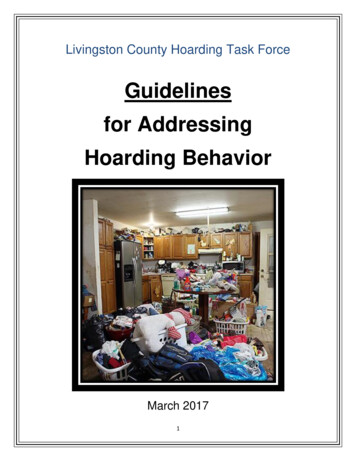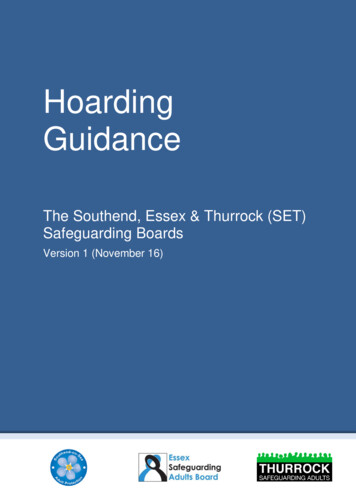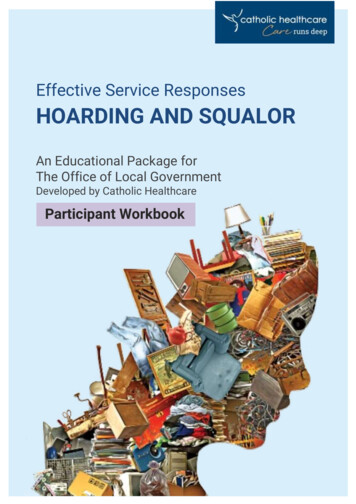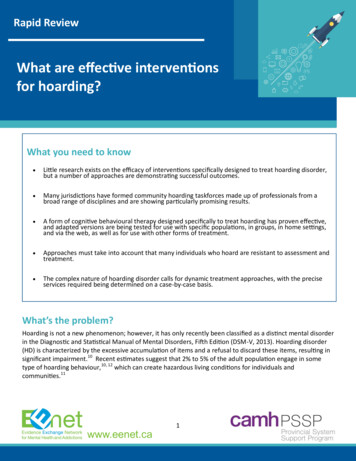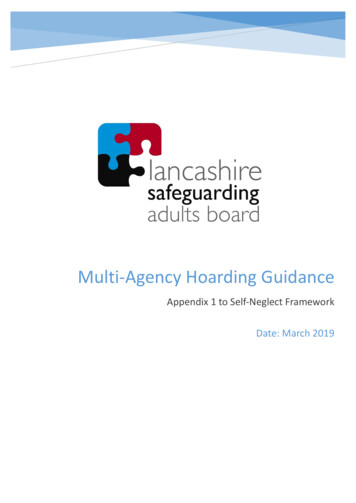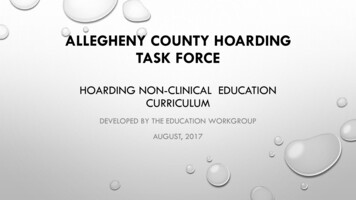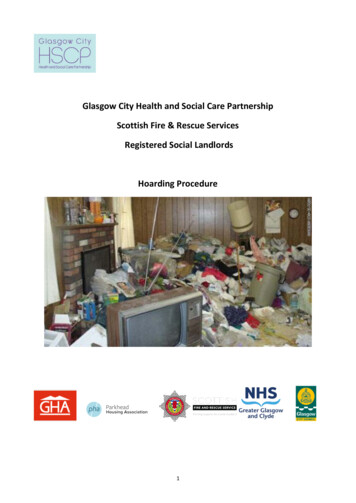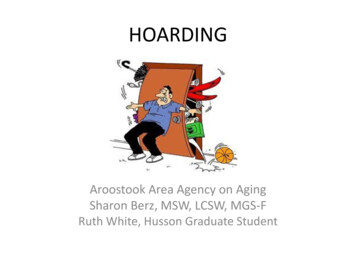
Transcription
HOARDINGAroostook Area Agency on AgingSharon Berz, MSW, LCSW, MGS-FRuth White, Husson Graduate Student
http://psychiatry.ucsd.edu/OCD hoarding.html
Hoarding pre-test 1. Compulsive hoarding is typically consideredwhat type of mental disorder? 2. How many Americans are compulsivehoarders? 3. Which of the following is not a cause ofcompulsive hoarding?
Hoarding Pre-test 4.What is the name of the assessment tooldeveloped by the National Study Group on chronicdisorganization? 5. T/F Not all hoarders excessively collect or saveobjects, some hoard animals. 6. Which is not a characteristic of hoarding?
Hoarding Pre-test 7. T/F Hoarding runs in families. 8. One of the following treatments is not usedas a strategy for alleviating hoardingsymptoms and triggers. 9. T/F Hoarding symptoms are commonly seenonly in adults. 10. Compulsive hoarders may be at risk forhealth issues due to all of the followingexcept:
Do you or someone you know acompulsive hoarding problem?Clutter?Distress caused by clutter: Can’t have friends over to yourhome embarrassed Keep the shades drawn so noone can see in Get in arguments over theclutter Are at risk of falling Feel depressed or anxiousbecause of the clutter Moving things from one pile toanother
Are you hanging on to: Junk mail Old catalogs, newspapers Items for sewing orcrafting-which you never do Things you may want to giveothers- but never do Clothes you’llwear someday Broken things you’llfix somedayAre you storing stuff & can’t use Beds –you can’t sleep inKitchens –unable to cook inTables-can’t eat onChairs or sofas can’t sit on
Compulsive hoarders Accumulate things in home that others maynot consider worth saving or stockpiling Clutter interferes with normal use of home The people may be impaired Not, “NOT less intelligent—have not learnedhow to manage the amount of stuff theyhave”(Ron Alford, Managing Director of Disaster Masters)
Case Studies
grahamdavey.blogspot.com
HoardingDSM-5 (300.3) 80-90% display excessive acquisition– Excessive buying– Acquisition of free items (leaflets, things discardedby others)
Diagnostic features Criteria APersistent difficultydiscarding or parting withpossessionsReasons: perceived utilities,aesthetic value, strongsentimental attachmentAvoid being wastefulFear of losing importantinformationCriteria B Save possessions &experience distress whenfacing the prospect ofdiscarding them Saving possessions isintentional
Diagnostic featuresCriterion C* Large numbers of items fillup and clutter active livingareas so that their intendeduse is no longer possible IE unable to cook in kitchen,sleep in bed, or sit on chair Emphasizes the “active”living areas of the homeItems filling up & clutteringliving spaceClutter is a large group ofusually unrelated ormarginally related objectspiled together in adisorganized fashion inspaces designed for otherpurposes(*DSM 5)
Diagnostic featuresInside a hoarders house*(DSM 5)Criterion D* Causes clinically significantdistress or impairment in asocial, occupational, orother or other importantareas of functioning Including maintaining a safeenvironment for self andothershttps://www.google.com/#q pictures of hoarding
Diagnostic features Criterion E*: It is not attributable to anothermedical condition Criterion F*: it is not better explained by thesymptoms of another mental disorder*DSM 5
www.clutterhoardingcleanup.com
RISK FACTORS Age- starts in early adolescence, around age 13 or 14, and it tendsto get worse with age. Younger children may start saving items,such as broken toys, pencil nubs, outdated school papers andbroken appliances. Family history- very strong association between having a familymember who is a compulsive hoarder and becoming a hoarderyourself. Stressful life events- Some people develop hoarding afterexperiencing a stressful life event that they had difficulty copingwith, such as the death of a loved one, divorce, eviction or losingpossessions in a fire. A history of alcohol abuse- About half of hoarders have a history ofalcohol dependence. Social isolation- People who hoard are typically socially withdrawnand ons/hoarding/basics/risk-factors/con-20031337
Hoarding Symptoms Cluttered living spaces Unable to throw thingsaway Difficulty organizing things Difficulty managing dailyactivities, includingprocrastination and troublemaking decisions Acquiring unneeded orseemingly useless items,including trash or napkinsfrom a restaurant Hoarders save randomitems they encounter intheir daily life and storethem haphazardly in theirhomes or surrounding areas Versus a ‘collector’ ofstamps, coins, which arecategorized conditions/hoarding/basics/symptoms/con-20031337
Mayo Clinic* “Hoarding, also called compulsive hoardingand compulsive hoarding syndrome, may be asymptom of obsessive-compulsive disorder(OCD). But many people who hoard don'thave other OCD-related ditions/hoarding/basics/definition/CON-20031337
What is hoarding? “a pattern of behavior that is characterized bythe excessive acquisition of and inability orunwillingness to discard large quantities ofobjects that cover the living areas of the homeand cause significant distress or impairment”**DSM 5
Is this hoarding or merely off/is-your-mom-or-dad-a-hoarder b 1365521.html#slide 807496
Hoarding contrasts Normal collecting isorganized andsystematic Does not produce theclutter, the distress, orimpairment There may be poorinsight, individual maynot report distress Any attempt to clear bya 3rd party results inlevels of distress
Common Features nDifficulty planning & organizing tasksDistractibility
Common Features*(*DMS 5) Unsanitary living conditions Animal hoarding-accumulating large # andfailure to provide minimal standards ofnutrition, sanitation, or vet care Most prominent difference between objectand animal hoarding: the extent of unsanitaryconditions and poor insight
Prevalance 2%-6% clinically significant in U.S. & Europe Both Men and Women (studies and reportslean both ways) 3x more prevalent in older adults (55-94yrs)compared to 34-44 yr olds
Development & Course*(*DSM 5) First emerges around 11-15 years of age Starts interfering in everyday function by mid20’s; causes clinically significant impairmentby mid-30’s Severity increases with each decade of life
Who? 3-6 million hoardersnationwide “Problematic clutteringbehavior” Older Americans whoexperienced the GreatDepression or WWII(www.tlc.com) Saved: rubber bands,paper bags, emptycereal boxes, aluminumfoil, Christmas paper,bows, brokenappliances
sive-hoarding More frequently in menDevelops earlier in womenCan be in children and can worsenCharacteristics:– Perfectionism– Depression or anxiety– Memory problems– Short attention spans
“Impaired Decision Making Traced to SalienceNetwork”(Study by NIMH 2012) “In patients with hoarding disorder, parts of adecision-making brain circuit under-activatedwhen dealing with others’ possessions, but over-activated when deciding whether tokeep or discard their own their-ownstuff.shtml
“Impaired Decision Making traced to SalienceNetwork”(study by NIMH 8/09/12 press release) “The new findings pinpoint brain circuitactivity suspected of underlying: the lack of self-insight, indecisiveness, sensethat the wrong decision is being made,inflated estimates of the desirability ofobjects, and exaggerated perception of risk that are often experienced with the ng-their-ownstuff.shtml
What happens physiologically? Patients had to decidewhether to keep or discardtheir own possessions; itunder-activated duringdecision-making aboutothers’ possessions. The leftand right insula (upper leftand right) similarlydifferentially activated inhoarding disorder patientsduring this task. (Picture shows fMRI datasuperimposed on structuralMRI scan)*Anterior cingulate cortex (center)over-activated when hoardingdisorder stuff.shtml
So what happens -hoarding Person talks frequently about h/h possessions Person does not let you into house or into acertain part of the house Person puts off repairs or paying bills Person shops often & acquiring more things Person very disorganized views cleaning &organizing as major tasks
WHY?Emotional attachment Sentimental value Associate the items as beingpart of their identity -hoardingNot wanting waste Each item has it’s ownpurpose May be able to use it in thefuture so would be a wasteto get rid of it
Why? Fear of losing important information– See items as a source of information– Save them for when they need it Genetics can be an underlying cause (85%) Can begin after strokes, surgery, injuries, orinfections Family experience/upbringing Psychological issues Brain abnormalities
Why? Have difficulty processing information Inability to focus on cleaning or organization Inability to make decisions when confrontedw/ large amounts of information Failure to categorize (can’t see commonality ofobjects) Worsens with age if symptomology existed inearly years
Inside a hoarders home http://search.yahoo.com/search?fr mcafee&p pictures of a home hoarding issu
Hoarding complications Unsanitary conditionsthat pose a risk to health Increased risk of falls An inability to performdaily tasks, such asbathing or cooking Poor work performance Family conflicts Loneliness and socialisolation A fire hazard
Mayo Clinic “People who hoard often don't see it as aproblem, making treatment challenging.But intensive treatment can help people whohoard understand their compulsions and livesafer, more enjoyable ns/hoarding/basics/definition/CON-20031337
Is this merely being untidy or is ff/is-your-mom-or-dad-a-hoarder b 1365521.html#slide 807947
Potential ?’s to ask Do you avoid throwing things away because youbelieve you might need them later, or becausethey have emotional significance? How often do you decide to acquire or keepthings you don't have space or use for? How would it make you feel if you had to discardsome of your things? Does the clutter in your home keep you fromusing rooms for their intended purpose, such ascooking, washing dishes or taking a bath?
Potential ?’s to ask Does clutter prevent you from inviting peopleto visit your home? How does clutter in your home affect yourfamily members? Does it take you a long time to perform dailytasks because of clutter or because you feel aneed to do things perfectly? Do you have so many pets that you can't carefor them properly?
?’s to ask Have others encouraged you to seekprofessional help? Do you have a first-degree relative — a parentor sibling — who is a pack rat? Are you currently being treated for any othermedical conditions, including mental illness?
Solutions Get inside the houseMonitor hoarding problemsApproach topic with sensitivity instead of judgmentDon’t refer to items as “junk” or “clutter”Ask: “what is it you can’t do that you would like todo?” Stay neutral and offer to help Support from those around them
ompulsive-hoarding Exposure and Response Prevention (ERP) Change how they think –Cognitive behavior therapy (CBT)– Uncover the underlying reason why– Help decide what’s important to keep & unnecessary Start thinking they are not chronically disorganized or theyneed help Get help to organize Realize they don’t need to be ashamed Medications-antidepressants Support groups (International OCD Foundation) Use Hoarding Scale for each room
Hoarding post test 1. Compulsive hoarding is typically consideredwhat type of mental disorder? Anxiety disorder 2. How many Americans are compulsivehoarders?3-6 million 3. Which of the following is not a cause ofcompulsive hoarding? Problems with aggression
Hoarding Post test 4.What is the name of the assessment tooldeveloped by the National Study Group on chronicdisorganization? Clutter-hoarding Scale 5. T/F Not all hoarders excessively collect or saveobjects, some hoard animals. TRUE 6.Which is not a characteristic of hoarding? Sleeping disturbances
Hoarding Post-test 7. T/F Hoarding runs in families. True 8. One of the following treatments is not used asa strategy for alleviating hoarding symptoms andtriggers. Residential treatment 9. T/F Hoarding symptoms are commonly seenonly in adults. False
Hoarding Post-test 10. Compulsive hoarders may be at risk forhealth issues due to all of the followingexcept: Stroke How did you do? out of 10
Aroostook Area Agency on Aging says: Thank you for your attention and interest inthis topic Be supportive of others Be an advocate for change in your community
Hoarding Resources Mayo Clinic Wade-Bennett life clutter tt.html http://www.hoarders.org/f-c.html IOCDF Hoarding Center,http://www.ocfoundation.org/hoarding/
Hoarding Resources cont. CHILDREN OF HOARDERS Web siteInformative web site for families and children of hoardershttp://www.childrenofhoarders.com/Harm Reduction for the Elderly- By John O'Brien Central Coast Senior Services"The goal is to work towards improving problematic behaviors while recognizingthey often can not be eliminated.It is a non-confrontational and non-judgmental approach. Not every older personcan stop or wants to stop risky behaviors. The person may not be in a physical orpsychological position to understand or consider their behavior is causing a problemand that change is possible. Harm Reduction accepts these ction/How to Get Hoarders Into Treatmentby Dr Fugen Neziroglu, PHD & Katherine Donnelly dcasts/hoarding-research-and-treatment When a Loved One Hoardsby David Tolin Author of Buried Treasures Oxford University Press"Some general principals to guide conversations:Show Empathy: Don't Argue; Respect Autonomy; Help the person recognize that his/her actionsare inconsistent with his/her greater goals or values."http://blog.oup.com/oupblog/2007/01/when a loved on.html
Hoarding resources cont. The Way to Help a Family Memberby R.Frost,PhDHow Compulsive Hoarding Affects Family found on IOCDF - Web spx#affects y.aspxCaring.com, Family Advisor, April 20, 2010Mom's a hoarder whose "stuff" is keeping us apart!by Carol elping Family Members Who HoardNew England Hoarding Consortium, Page 13 of Hoarding Newsletter, /PSYCH/rfrost/Spring 2009 Hoarding Newsletter.pdf
Hoarding websites rms/mi rationale techniques.pdf Help for Hoarders:10 small stepsby DorothyBreiningerhttp://savingourparents.com/tips db.php?key Help for Hoarders&last 1214Clutter and Hoarding http:cornellaging.org/gem/hoarding index.htmlAnimal Hoarding and FamiliesTips for families and friendsIntervention is possible but challenging, requiring tact andpatience.The Hoarding of Animals Research Consortium .htm
Groups on line "Spouses of Hoarders"Yahoo Group run by Sandra Felton of Messies essies/For friends and familyThis group is for those who care about someone who is a hoarder. It is not atherapy group. Here we share informationwhich may be useful in understanding those whose lives are impacted byhoarding. Perhaps some ideas for approaches will prove useful.This site is run by Sandra Felton organizer of Messies nds-of-Hoarders/ -shameful-secret14225893Surviving a Filthy Childhood: Jessie Sholl, Daughter of Hoarder, Comes -childhood-daughter-hoarderclean/story?id 14222198
Books Helping Your Loved One Manage Clutter, Hoarding & Compulsive Acquiringby Tamara Hart PhD., Michael Tompkins, PhD.New Harbinger Publications 2009This book gives manageable steps for helping your loved one make gradual andlasting change. Buried in Treasurers- help for Compulsive Acquiring, Saving, and Hoardingby David Tolin, Randy Frost, Gail Steketee.Oxford University Press, 2007Useful information to help friends and family understand.It includes strategies and techniques that anyone can use.
Videos ABC News Videos, 20/20, August 05, 3011Hoarder's Children Speak Out 8808 Hoarders Daughter Keeps Shameful Secret shameful-secret-14225893Surviving a Filthy Childhood: Jessie Sholl, Daughter ofHoarder, Comes Clean hood-daughter-hoarder-clean/story?id 14222198
References mom-or-dad-a-hoarder b 1365521.htmlhttp://www.bing.com/images/search?q hoarding &id EAA450499504DB8CB311D458F5CDA8063A6986E9&FORM ulsive-hoardingDSM tp://www.bing.com/images/search?q hoarding &id EAA450499504DB8CB311D458F5CDA8063A6986E9&FORM IQFRBA#view detail&id ndex 36
up and clutter active living areas so that their intended use is no longer possible IE unable to cook in kitchen, sleep in bed, or sit on chair . Use Hoarding Scale for each room . Hoarding post test 1. Compulsive hoarding is typically considered what type of mental disorder? Anxiety disorder
